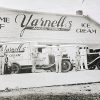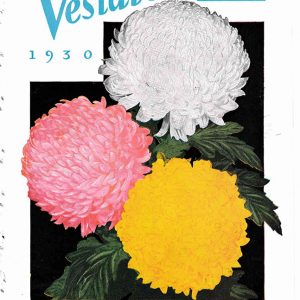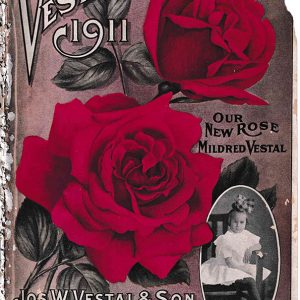calsfoundation@cals.org
Vestal Nursery
aka: J. W. Vestal & Son
The Vestal Nursery, based in the Baring Cross neighborhood of North Little Rock (Pulaski County), operated for more than 100 years, cultivating and shipping flowers across the United States. By the mid-twentieth century, it had one of the largest greenhouse spaces in the United States.
Joseph Wysong Vestal, a Quaker horticulturist in Cambridge City, Indiana, grew and sold plants as early as 1855, following prior Vestal family advancements in horticultural technology. By 1860, J. W. Vestal was cultivating greenhouse flowers. As the Arkansas Democrat Magazine wrote, “From 300 square feet of glass, he made additions annually, thus being able to accumulate an astonishingly large variety of plants.” In 1861, Vestal began publishing an annual floral and vegetable catalogue first titled “Roses, New Plants, and Special Merit Plants,” establishing Vestal as one of the first U.S. mail-order operations in existence. The catalogue was published for ninety-three consecutive years.
Seeking both a warmer climate and a more favorable shipping radius, the forty-four-year-old J. W. Vestal relocated in 1880 to the north bank of the Arkansas River, adjacent to the 1873 Baring Cross railway bridge at what was then part of Little Rock (Pulaski County). The location choice was influenced by the availability of low-cost riverine agricultural land from the Iron Mountain Railroad. By 1880, annual sales exceeded $8,000, and plants were shipped to all states east of the Rocky Mountains, especially to Chicago and St. Louis. By 1884, fresh flowers were sold daily through Hughes’s Drugstore, at the corner of Little Rock’s Main and Second streets. J. W. Vestal added his youngest son, Charles Howell Vestal, to the business name in 1890.
With the notation of “Re-Established at Little Rock, 1881,” J. W. Vestal & Son continued publication of the annual catalogue of “Select, New, Rare, and Beautiful Plants; Roses.” Vestal’s business publicity prompted the City of Little Rock’s unsuccessful attempt to annex the Vestal agricultural lands in 1891. In an Arkansas Supreme Court case decided by Judge Uriah M. Rose, this attempt was rejected. This decision helped motivate the Argenta community to organize into what is today the city of North Little Rock.
Indicating the depth and diversity of all plant offerings, the 1906 catalog listed more than 170 distinctive varieties of strawberries, in a wide assortment of shapes, sizes, and colors, including purple and orange. In 1914, J. W. Vestal & Son mailed a total of 50,000 eighty-page catalogues to worldwide customers. The Flood of 1927 reached its peak on April 20, 1927, inundating the Vestal riverine lands. However, the greenhouses contained plant benches several feet above the peak flood level, and the rose nursery was on high ground, saving the majority of the crops from devastation.
The J. W. Vestal & Son company was known for roses and magnolias. The most popular Vestal rose was the thornless David O. Dodd, developed in 1926 and honoring a local Confederate hero. The David O. Dodd was advertised as “a magnificent rich crimson, flushed scarlet with well-shaped buds, carried erect and opening into a large, beautifully shaped flower.” The rose became the official flower of the 1936 Arkansas Centennial Celebration, and Little Rock became known as the “City of Roses.” Former Purdue University horticulture professor George Vestal, oldest son of Joseph, worked in the nursery business developing magnolia and evergreen trees until his untimely death in 1898. His magnolia trees survive in the twenty-first century along both River Road in North Little Rock and in front of his former homeplace on Roosevelt Ave. in Little Rock.
Following the 1928 death of Charles Vestal, the business changed from primarily supplying mail-order retail customers to supporting the regional wholesale market of florists, nurseries, and other retailers, under the third-generation leadership of Charles Howell Vestal and his brother, Joseph Walter Vestal.
By 1957, J. W. Vestal & Son operations grossed over a million dollars in annual revenue with about eighty employees in one of the largest U.S. greenhouse ranges. The greenhouses totaled more than 300,000 square feet under glass and were heated by steam from three large coal-burning boilers, later converted to natural gas. Hundreds of acres of nursery fields were also in production. Cut-flower buildings with refrigeration were constructed and a retail store operated in the Marion Hotel, with a second wholesale location established in Fort Smith (Sebastian County). During the 1950s, J. W. Vestal & Son produced more than 1.2 million cut chrysanthemums and 750,000 cut roses on a year-round basis.
The annual catalogs ceased publication with the fall 1954 issue, following the death of Charles Vestal. From 1954 until 1967, Joseph Vestal oversaw operations. In 1967, third- and fourth-generation family members Ruth Vestal and Kent Vestal merged two-thirds of the existing business assets into a new corporation, Kent Vestal Company, Inc., and continued in retail and wholesale florist endeavors until 1977, when the business was sold to publicly held Florafax International of Tulsa, Oklahoma. The remaining one-third business interest was held by Joseph Vestal’s family, who operated greenhouses until filing bankruptcy in the mid-1980s.
On the original river site, all that remains of Vestal Nursery in the twenty-first century is the ninety-foot brick smokestack built in the early 1930s to replace the original taller smokestack damaged by the 1927 flood. The original Vestal farm, purchased at the end of the nineteenth century to provide access to rich bottomland topsoil (Vestal Blvd. at Maumelle Blvd. in North Little Rock), remains in family hands with new horticultural production being planned.
For additional information:
“Among the New Businesses.” Arkansas Gazette, June 26, 1881, p. 4.
“Annexation. Vestal Left Out in the City’s Amended Petition.” Arkansas Gazette, March 17, 1891, pp. 2, 3.
“C. H. Vestal, Florist, Dies.” Arkansas Gazette, September 2, 1954, p. 10.
Dean, J. “Descendant of Rose Developed in 1926 Is Object of Search.” Arkansas Gazette, October 29, 1984, p. 1B.
Dillard, Tom. “Grass Rules Where Vestals’ Once Mighty Garden Grew.” Arkansas Democrat-Gazette Travel Section, March 16, 2003, p. 5.
———. “The Luther Burbank of Arkansas: Joseph W. Vestal and the Company He Created.” Pulaski County Historical Review 49 (Fall 2001): 50–55.
“A Farm of Flowers: The Large Gardens of J. W. Vestal.” Arkansas Democrat, October 7, 1880, p. 4.
“Flowers and Plants.” Arkansas Gazette, March 24, 1888, p. 3.
“Tube Roses Cut Flowers.” Arkansas Gazette, September 26, 1884, p. 4.
Vestal, Sarah. “Joseph Wysong Vestal’s Horticultural Legacy, Sweet Potatoes to Blueberries.” Pulaski County Historical Review 67 (Fall 2019): 70–83.
Vestal Nursery Collection. Archives, University of Central Arkansas, Conway, Arkansas. Finding aid online at https://uca.edu/archives/m86-03-vestal-nursery-collection/ (accessed June 10, 2022).
Vestal Nursery and Family Collection. Butler Center for Arkansas Studies. Central Arkansas Library System, Little Rock, Arkansas. https://arstudies.contentdm.oclc.org/digital/search/searchterm/mss.02.26 (accessed June 10, 2022).
Williams, Fay. Arkansans of the Years Volume 3. Little Rock: C. C. Allard and Associates, 1953.
Sarah A. Vestal
Little Rock, Arkansas

 Garden Hints
Garden Hints  Spring Catalog
Spring Catalog 



Comments
No comments on this entry yet.